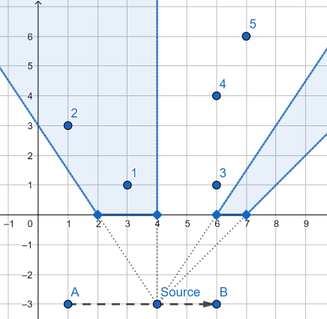There is a light source on the plane. This source is so small that it can be represented as point. The light source is moving from point $$$(a, s_y)$$$ to the $$$(b, s_y)$$$ $$$(s_y < 0)$$$ with speed equal to $$$1$$$ unit per second. The trajectory of this light source is a straight segment connecting these two points.
There is also a fence on $$$OX$$$ axis represented as $$$n$$$ segments $$$(l_i, r_i)$$$ (so the actual coordinates of endpoints of each segment are $$$(l_i, 0)$$$ and $$$(r_i, 0)$$$). The point $$$(x, y)$$$ is in the shade if segment connecting $$$(x,y)$$$ and the current position of the light source intersects or touches with any segment of the fence.

You are given $$$q$$$ points. For each point calculate total time of this point being in the shade, while the light source is moving from $$$(a, s_y)$$$ to the $$$(b, s_y)$$$.
First line contains three space separated integers $$$s_y$$$, $$$a$$$ and $$$b$$$ ($$$-10^9 \le s_y < 0$$$, $$$1 \le a < b \le 10^9$$$) — corresponding coordinates of the light source.
Second line contains single integer $$$n$$$ ($$$1 \le n \le 2 \cdot 10^5$$$) — number of segments in the fence.
Next $$$n$$$ lines contain two integers per line: $$$l_i$$$ and $$$r_i$$$ ($$$1 \le l_i < r_i \le 10^9$$$, $$$r_{i - 1} < l_i$$$) — segments in the fence in increasing order. Segments don't intersect or touch each other.
Next line contains single integer $$$q$$$ ($$$1 \le q \le 2 \cdot 10^5$$$) — number of points to check.
Next $$$q$$$ lines contain two integers per line: $$$x_i$$$ and $$$y_i$$$ ($$$1 \le x_i, y_i \le 10^9$$$) — points to process.
Print $$$q$$$ lines. The $$$i$$$-th line should contain one real number — total time of the $$$i$$$-th point being in the shade, while the light source is moving from $$$(a, s_y)$$$ to the $$$(b, s_y)$$$. The answer is considered as correct if its absolute of relative error doesn't exceed $$$10^{-6}$$$.
-3 1 6
2
2 4
6 7
5
3 1
1 3
6 1
6 4
7 6
5.000000000000000
3.000000000000000
0.000000000000000
1.500000000000000
2.000000000000000
- The 1-st point is always in the shade;
- the 2-nd point is in the shade while light source is moving from $$$(3, -3)$$$ to $$$(6, -3)$$$;
- the 3-rd point is in the shade while light source is at point $$$(6, -3)$$$.
- the 4-th point is in the shade while light source is moving from $$$(1, -3)$$$ to $$$(2.5, -3)$$$ and at point $$$(6, -3)$$$;
- the 5-th point is in the shade while light source is moving from $$$(1, -3)$$$ to $$$(2.5, -3)$$$ and from $$$(5.5, -3)$$$ to $$$(6, -3)$$$;
| Name |
|---|




